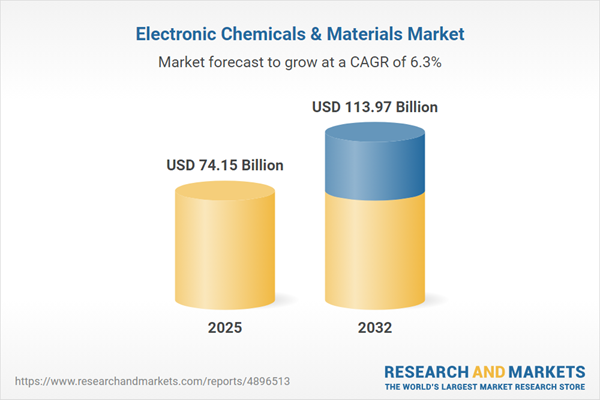Speak directly to the analyst to clarify any post sales queries you may have.
The Electronic Chemicals & Materials Market is experiencing notable transformation, fueled by rising demand for advanced semiconductor technologies and the need for sustainable manufacturing practices. Decision-makers require up-to-date insights and in-depth segmentation to inform resilient, growth-focused strategies across global operations.
Market Snapshot: Electronic Chemicals & Materials Market Size and Growth
The Electronic Chemicals & Materials Market grew from USD 69.96 billion in 2024 to USD 74.15 billion in 2025. It is expected to continue growing at a CAGR of 6.28%, reaching USD 113.97 billion by 2032.
Scope & Segmentation of the Electronic Chemicals & Materials Market
This research offers a detailed breakdown of the electronic chemicals and materials sector, with coverage of product categories, purity requirements, applications, end-user industries, distribution channels, and key regions:
- Product Types: Electronic chemicals—including conductive polymers, dielectric materials, encapsulants, silicon wafers, sputtering targets, and substrates; electronic materials—including CMP slurries, developers, etchants, photoresists, solvents & acids, specialty gases, and strippers.
- Purity Grades: High purity and ultra-high purity (UHP) chemicals critical to semiconductor and electronics manufacturing.
- Product Forms: Gas, liquid, and solid, each facilitating specific handling and logistics requirements.
- Applications: Bonding & packaging, cleaning & etching, doping, encapsulation, layer deposition, lithography, and surface preparation, spanning every stage of electronic device fabrication.
- End-Use Industries: Aerospace & defense, electronics, energy, healthcare, and telecommunications—each shaping unique demand for tailored chemical solutions.
- Distribution Channels: Offline and online models support diverse buyer needs and procurement strategies.
- Regions Covered: Americas (including United States, Canada, Mexico, Brazil, Argentina, Chile, Colombia, Peru), Europe, Middle East & Africa (including United Kingdom, Germany, France, Russia, Italy, Spain, Netherlands, Sweden, Poland, Switzerland, UAE, Saudi Arabia, Qatar, Turkey, Israel, South Africa, Nigeria, Egypt, Kenya), Asia-Pacific (including China, India, Japan, Australia, South Korea, Indonesia, Thailand, Malaysia, Singapore, Taiwan).
Key Takeaways for Senior Decision-Makers
- Advanced technologies such as extreme ultraviolet lithography are accelerating demand for ultra-pure materials and specialized chemistries across semiconductor value chains.
- Environmental regulations and sustainability mandates are catalyzing adoption of green chemistry principles, solvent recovery frameworks, and closed-loop processing systems across all regions.
- Supply chain resilience and transparency have gained strategic importance, driving diversification of sourcing strategies and investment in regional production hubs.
- Collaborative partnerships between specialty chemical providers and semiconductor manufacturers are key to early-stage innovation, efficiency, and alignment in material development cycles.
- Digital tools—including predictive analytics and AI-enabled quality controls—are becoming crucial for yield optimization, operational efficiency, and real-time process monitoring in advanced manufacturing facilities.
- Regional market growth is shaped by distinct investment priorities, from onshoring and incentives in the Americas to carbon-neutral policies and circular economy initiatives in EMEA, and rapid expansion of foundries across Asia-Pacific.
Tariff Impact on Supply Chains and Competitive Strategies
Recently introduced tariffs on electronic chemicals have compelled organizations to reconsider logistics networks, diversify sourcing, and engage in near-shoring initiatives. This regulatory shift has heightened the emphasis on advanced risk modelling to account for duties, freight, and volatility, encouraging companies to build robust, transparent supply chains ready for rapid policy change.
Research Methodology & Data Sources
This report is based on primary insights from interviews with industry executives, process engineers, and procurement specialists, complemented by secondary research from technical literature, regulatory analysis, and white papers. Triangulation of proprietary supplier data and expert validation ensures recommendations are reliable and actionable.
Why This Report Matters to Decision-Makers
- Informs R&D, sourcing, and investment decisions with segmentation and regional analysis tailored to address performance, compliance, and market opportunity.
- Equips leadership with actionable insights on regulatory trends, technology innovation, and strategic partnerships to support business continuity and sustainable growth.
- Supports risk management by clarifying tariff impacts, supply chain vulnerabilities, and alternative operational models.
Conclusion
The Electronic Chemicals & Materials Market is navigating rapid innovation and shifting regulatory dynamics. Robust segmentation, supply chain agility, and investments in digital and sustainable practices will be essential for sustaining growth and competitive advantage in emerging global markets.
Additional Product Information:
- Purchase of this report includes 1 year online access with quarterly updates.
- This report can be updated on request. Please contact our Customer Experience team using the Ask a Question widget on our website.
Table of Contents
3. Executive Summary
4. Market Overview
7. Cumulative Impact of Artificial Intelligence 2025
Companies Mentioned
The companies profiled in this Electronic Chemicals & Materials market report include:- Albemarle Corporation
- BASF SE
- FUJIFILM Holdings Corporation
- Hitachi, Ltd.
- Honeywell International, Inc.
- Huntsman Corporation
- JSR Corporation
- L’AIR LIQUIDE S.A.
- Merck KGaA
- Shin-Etsu Chemical Co., Ltd.
- Solvay S.A.
- Songwon Industrial Co., Ltd.
- The Dow Chemical Company
- Avantor Inc.
- Borregaard AS
- Celanese Corporation
- Daicel Corporation
- Daikin Industries Ltd.
- Eastman Chemical Company
- Ineos AG
- Kanto Chemical Co., Inc.
- LANXESS AG
- Linde PLC
- Mitsubishi Chemical Corporation
- Otto Chemie Pvt. Ltd.
- Sinochem Holdings Corporation Ltd.
Table Information
| Report Attribute | Details |
|---|---|
| No. of Pages | 194 |
| Published | November 2025 |
| Forecast Period | 2025 - 2032 |
| Estimated Market Value ( USD | $ 74.15 Billion |
| Forecasted Market Value ( USD | $ 113.97 Billion |
| Compound Annual Growth Rate | 6.2% |
| Regions Covered | Global |
| No. of Companies Mentioned | 27 |








